Garmin G1000 User Manual

G1000® Integrated Flight Deck
Pilot’s Guide
Cessna Nav III

SYSTEM OVERVIEW
FLIGHT INSTRUMENTS
EIS
AUDIO PANEL & CNS
FLIGHT MANAGEMENT
HAZARD AVOIDANCE
AFCS
ADDITIONAL FEATURES
APPENDICES
INDEX

Copyright © 2004-2011 Garmin Ltd. or its subsidiaries. All rights reserved.
This manual reflects the operation of System Software version 0563.25 or later for Cessna 172R, 172S, 182T, T182T, 206H, and T206H aircraft. Some differences in operation may be observed when comparing the information in this manual to earlier or later software versions.
NOTE: Cessna Nav III aircraft include the Cessna 172R, the Cessna 172S, the normally aspirated Cessna 182 (182), the turbocharged Cessna 182 (T182), the normally aspirated Cessna 206 (206), and the turbocharged Cessna 206 (T206). Unless otherwise indicated, information in the G1000 Cockpit Reference Guide pertains to all Cessna Nav III aircraft.
Garmin International, Inc., 1200 East 151st Street, Olathe, Kansas 66062, U.S.A.
Tel: 913/397.8200 |
Fax: 913/397.8282 |
Garmin AT, Inc., 2345 Turner Road SE, Salem, OR 97302, U.S.A. |
|
Tel: 503/391.3411 |
Fax 503/364.2138 |
Garmin (Europe) Ltd, Liberty House, Bulls Copse Road, Hounsdown Business Park, Southampton, SO40 9RB, U.K. |
|
Tel: 44/0870.8501241 |
Fax: 44/0870.8501251 |
Garmin Corporation, No. 68, Jangshu 2nd Road, Shijr, Taipei County, Taiwan |
|
Tel: 886/02.2642.9199 |
Fax: 886/02.2642.9099 |
For after-hours emergency, aircraft on ground (AOG) technical support for Garmin panel mount and integrated avionics systems, please contact Garmin’s AOG Hotline at 913.397.0836.
Web Site Address: www.garmin.com
Except as expressly provided herein, no part of this manual may be reproduced, copied, transmitted, disseminated, downloaded or stored in any storage medium, for any purpose without the express written permission of Garmin. Garmin hereby grants permission to download a single copy of this manual and of any revision to this manual onto a hard drive or other electronic storage medium to be viewed for personal use, provided that such electronic or printed copy of this manual or revision must contain the complete text of this copyright notice and provided further that any unauthorized commercial distribution of this manual or any revision hereto is strictly prohibited.
Garmin® and G1000® are registered trademarks of Garmin Ltd. or its subsidiaries. FliteCharts®, and SafeTaxi® are trademarks of Garmin Ltd. or its subsidiaries. These trademarks may not be used without the express permission of Garmin.
NavData® is a registered trademark of Jeppesen, Inc.; Stormscope® is a registered trademark of L-3 Communications; and XM® is a registered trademark of XM Satellite Radio, Inc.; Honeywell® and Bendix/King® are registered trademarks of Honeywell International, Inc.; CO Guardian is a trademark of CO Guardian, Inc.
October, 2011 |
190-00498-07 Rev. A |
Printed in the U.S.A. |
Garmin G1000 Pilot’s Guide for Cessna Nav III |
190-00498-07 Rev. A |

LIMITED WARRANTY
LIMITED WARRANTY
Within the warranty period, Garmin will, at its sole discretion, repair or replace any components that fail in normal use. Such repairs or replacement will be made at no charge to the customer for parts and/or labor incidental to the direct repair of said product. Garmin may, at its discretion with prior approval, reimburse an authorized Garmin Service Center for associated labor costs incurred for removal and replacement of the panel mount product installed in an aircraft. The customer shall be responsible for any transportation or other cost. This warranty does not apply to: (i) cosmetic damage, such as scratches, nicks and dents; (ii) consumable parts, such as batteries, unless product damage has occurred due to a defect in materials or workmanship; (iii) damage caused by accident, abuse, misuse, water, flood, fire, or other acts of nature or external causes; (iv) damage caused by service performed by anyone who is not an authorized service provider of Garmin; or (v) damage to a product that has been modified or altered without the written permission of Garmin. In addition, Garmin reserves the right to refuse warranty claims against products or services that are obtained and/or used in contravention of the laws of any country.
THE WARRANTIES AND REMEDIES CONTAINED HEREIN ARE EXCLUSIVE AND IN LIEU OF ALL OTHER WARRANTIES, WHETHER EXPRESS, IMPLIED OR STATUTORY, INCLUDING ANY LIABILITY ARISING UNDER ANY WARRANTY OF MERCHANTABILITY OR FITNESS FOR A PARTICULAR PURPOSE, STATUTORY OR OTHERWISE. THIS WARRANTY GIVES YOU SPECIFIC LEGAL RIGHTS, WHICH MAY VARY FROM STATE TO STATE.
IN NO EVENT SHALL GARMIN BE LIABLE FOR ANY INCIDENTAL, SPECIAL, INDIRECT OR CONSEQUENTIAL DAMAGES, WHETHER RESULTING FROM THE USE, MISUSE, OR INABILITY TO USE THIS PRODUCT OR FROM DEFECTS IN THE PRODUCT. Some states do not allow the exclusion of incidental or consequential damages, so the above limitations may not apply in every case.
Garmin retains the exclusive right to repair or replace (with a new or newly-overhauled replacement product) the product or offer a full refund of the purchase price at its sole discretion. SUCH REMEDY SHALL BE YOUR SOLE AND EXCLUSIVE REMEDY FOR ANY BREACH OF WARRANTY.
To obtain warranty service, contact your local Garmin Authorized Service Center. For assistance in locating the nearest Service Center, call Garmin Customer Service at one of the numbers listed below.
Products sold through online auctions are not eligible for warranty coverage or rebates or other special offers from Garmin. Online auction confirmations are not accepted for warranty verification.To obtain warranty service, an original or copy of the sales receipt from the original retailer is required. Garmin will not replace missing components from any package purchased through an online auction.
Garmin International Inc. |
|
Garmin (Europe) Ltd. |
|
|
1200 East 151st Street, Olathe, Kansas 66062 |
Liberty House, Bulls Copse Road, Southampton, SO40 |
|||
Telephone: |
(913)397-8200 |
9RB, UK |
|
|
Telephone Toll Free: |
(888)606-5482 |
Telephone: |
++44 (0) |
870-8501243 |
Facsimile: |
(913)397-8282 |
Telephone Toll Free: |
++44 (0) |
0808 238 0000 |
Facsimile Toll Free: |
(800)801-4670 |
(option 5) |
|
|
E-mail: orders@garmin.com |
Facsimile: |
++44 (0) |
238052004 |
|
avionics@garmin.com |
E-mail: avionics.europe@garmin.com |
|||
warranty@garmin.com |
|
|
|
|
190-00498-07 Rev. A |
Garmin G1000 Pilot’s Guide for Cessna Nav III |
i |

WARNINGS, CAUTIONS, AND NOTES
WARNING: Navigation and terrain separation must NOT be predicated upon the use of the terrain avoidance feature. The terrain avoidance feature is NOT intended to be used as a primary reference for terrain avoidance and does not relieve the pilot from the responsibility of being aware of surroundings during flight. The terrain avoidance feature is only to be used as an aid for terrain avoidance. Terrain data is obtained from third party sources. Garmin is not able to independently verify the accuracy of the terrain data.
WARNING: The displayed minimum safe altitudes (MSAs) are only advisory in nature and should not be relied upon as the sole source of obstacle and terrain avoidance information. Always refer to current aeronautical charts for appropriate minimum clearance altitudes.
WARNING: The altitude calculated by G1000 GPS receivers is geometric height above Mean Sea Level and could vary significantly from the altitude displayed by pressure altimeters, such as the GDC 74A Air Data Computer, or other altimeters in aircraft. GPS altitude should never be used for vertical navigation. Always use pressure altitude displayed by the G1000 PFD or other pressure altimeters in aircraft.
WARNING: Do not use outdated database information. Databases used in the G1000 system must be updated regularly in order to ensure that the information remains current. Pilots using any outdated database do so entirely at their own risk.
WARNING: Do not use basemap (land and water data) information for primary navigation. Basemap data is intended only to supplement other approved navigation data sources and should be considered as an aid to enhance situational awareness.
WARNING: Traffic information shown on system displays is provided as an aid in visually acquiring traffic. Pilots must maneuver the aircraft based only upon ATC guidance or positive visual acquisition of conflicting traffic.
WARNING: Use of the Stormscope is not intended for hazardous weather penetration (thunderstorm penetration). Stormscope information, as displayed on the G1000 MFD, is to be used only for weather avoidance, not penetration.
WARNING: Do not use datalink weather products (e.g., XM WX Satellite Weather, GFDS World Wide Weather, or FIS-B) for hazardous weather penetration. Weather information provided by these products is aged by up to several minutes and may not depict actual weather conditions as they currently appear.
WARNING: NEXRAD weather data is to be used for long-range planning purposes only. Due to inherent delays in data transmission and the relative age of the data, NEXRAD weather data should not be used for short-range weather avoidance.
ii |
Garmin G1000 Pilot’s Guide for Cessna Nav III |
190-00498-07 Rev. A |

WARNINGS, CAUTIONS, AND NOTES
 WARNING: For safety reasons, G1000 operational procedures must be learned on the ground.
WARNING: For safety reasons, G1000 operational procedures must be learned on the ground.
WARNING: The Garmin G1000, as installed in Cessna Nav III aircraft, has a very high degree of functional integrity. However, the pilot must recognize that providing monitoring and/or self-test capability for all conceivable system failures is not practical. Although unlikely, it may be possible for erroneous operation to occur without a fault indication shown by the G1000. It is thus the responsibility of the pilot to detect such an occurrence by means of cross-checking with all redundant or correlated information available in the cockpit.
WARNING: The United States government operates the Global Positioning System and is solely responsible for its accuracy and maintenance. The GPS system is subject to changes which could affect the accuracy and performance of all GPS equipment. Portions of the Garmin G1000 utilize GPS as a precision electronic NAVigation AID (NAVAID). Therefore, as with all NAVAIDs, information presented by the G1000 can be misused or misinterpreted and, therefore, become unsafe.
WARNING: To reduce the risk of unsafe operation, carefully review and understand all aspects of the G1000 Pilot’s Guide documentation. Thoroughly practice basic operation prior to actual use. During flight operations, carefully compare indications from the G1000 to all available navigation sources, including the information from other NAVAIDs, visual sightings, charts, etc. For safety purposes, always resolve any discrepancies before continuing navigation.
WARNING: The illustrations in this guide are only examples. Never use the G1000 to attempt to penetrate a thunderstorm. Both the FAA Advisory Circular, Subject: Thunderstorms, and the Airman’s Information Manual (AIM) recommend avoiding “by at least 20 miles any thunderstorm identified as severe or giving an intense radar echo.”
WARNING: Because of variation in the earth’s magnetic field, operating the system within the following areas could result in loss of reliable attitude and heading indications. North of 72° North latitude at all longitudes. South of 70° South latitude at all longitudes. North of 65° North latitude between longitude 75° W and 120° W. (Northern Canada). North of 70° North latitude between longitude 70° W and 128° W. (Northern Canada). North of 70° North latitude between longitude 85° E and 114° E. (Northern Russia). South of 55° South latitude between longitude 120° E and 165° E. (Region south of Australia and New Zealand).
WARNING: Do not use GPS to navigate to any active waypoint identified as a ‘NON WGS84 WPT’ by a system message. ‘NON WGS84 WPT’ waypoints are derived from an unknown map reference datum that may be incompatible with the map reference datum used by GPS (known as WGS84) and may be positioned in error as displayed.
190-00498-07 Rev. A |
Garmin G1000 Pilot’s Guide for Cessna Nav III |
iii |
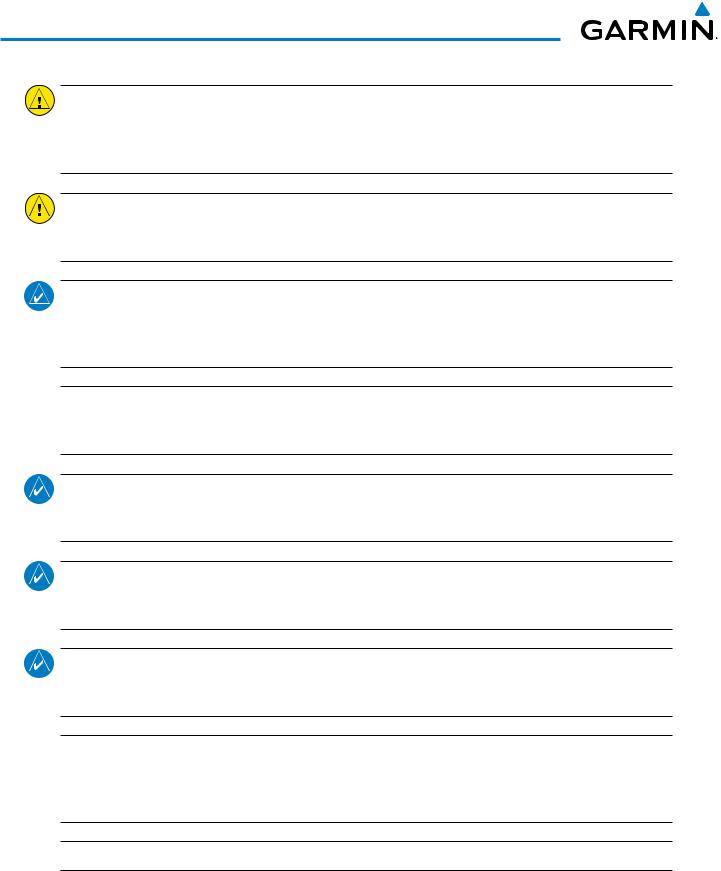
WARNINGS, CAUTIONS, AND NOTES
CAUTION: The PFD and MFD displays use a lens coated with a special anti-reflective coating that is very sensitive to skin oils, waxes, and abrasive cleaners. CLEANERS CONTAINING AMMONIA WILL HARM THE ANTI-REFLECTIVE COATING. It is very important to clean the lens using a clean, lint-free cloth and an eyeglass lens cleaner that is specified as safe for anti-reflective coatings.
CAUTION: The Garmin G1000 does not contain any user-serviceable parts. Repairs should only be made by an authorized Garmin service center. Unauthorized repairs or modifications could void both the warranty and the pilot’s authority to operate this device under FAA/FCC regulations.
NOTE:When using Stormscope,there are several atmospheric phenomena in addition to nearby thunderstorms that can cause isolated discharge points in the strike display mode. However, clusters of two or more discharge points in the strike display mode do indicate thunderstorm activity if these points reappear after the screen has been cleared.
 NOTE: Interference from GPS repeaters operating inside nearby hangars can cause an intermittent loss of attitude and heading displays while the aircraft is on the ground. Moving the aircraft more than 100 yards away from the source of the interference should alleviate the condition.
NOTE: Interference from GPS repeaters operating inside nearby hangars can cause an intermittent loss of attitude and heading displays while the aircraft is on the ground. Moving the aircraft more than 100 yards away from the source of the interference should alleviate the condition.
NOTE: All visual depictions contained within this document, including screen images of the G1000 panel and displays, are subject to change and may not reflect the most current G1000 system and aviation databases. Depictions of equipment may differ slightly from the actual equipment.
NOTE:This device complies with part 15 of the FCC Rules. Operation is subject to the following two conditions:
(1) this device may not cause harmful interference, and (2) this device must accept any interference received, including interference that may cause undesired operation.
NOTE: The GDU 1040 PFD/MFD may require a warm-up time of up to 30 minutes when exposed to -40˚C for an extended period. A warm-up time of up to 15 minutes may be required when exposed to -30˚C for an extended period.
 NOTE: This product, its packaging, and its components contain chemicals known to the State of California to cause cancer, birth defects, or reproductive harm. This notice is being provided in accordance with California’s Proposition 65. If you have any questions or would like additional information, please refer to our web site at www.garmin.com/prop65.
NOTE: This product, its packaging, and its components contain chemicals known to the State of California to cause cancer, birth defects, or reproductive harm. This notice is being provided in accordance with California’s Proposition 65. If you have any questions or would like additional information, please refer to our web site at www.garmin.com/prop65.
 NOTE: Use of polarized eyewear may cause the flight displays to appear dim or blank.
NOTE: Use of polarized eyewear may cause the flight displays to appear dim or blank.
iv |
Garmin G1000 Pilot’s Guide for Cessna Nav III |
190-00498-07 Rev. A |

REVISION INFORMATION
Record of Revisions
Part Number |
Revision |
Date |
Page Range |
Description |
190-00498-00 |
A |
10/27/05 |
i - I-4 |
Reformatted for single part number (all previous part numbers |
|
|
|
|
incorporated into this part number) |
|
|
|
|
Added TAWS-B |
|
|
|
|
Added CO Guardian |
|
|
|
|
Added new fuel totalizer |
190-00498-01 |
A |
9/11/06 |
i - I-6 |
Added GFC 700 AFCS |
|
|
|
|
Added WAAS and VNAV |
|
|
|
|
Added Chartview, Flitecharts, and SafeTaxi |
|
|
|
|
Added GDU 7.00 parameters |
|
|
|
|
Change manual to larger format |
|
|
|
|
|
190-00498-02 |
A |
3/8/07 |
i - I-6 |
Added Airways |
|
|
|
|
Added ADS-B |
|
|
|
|
Added GDU 8.02 parameters |
|
|
|
|
Various clerical changes |
190-00498-03 |
A |
11/6/07 |
i - I-6 |
Added GDU 8.20 parameters, including gradient background on |
|
|
|
|
the PFD and GFC 700 for the C172. |
190-00498-04 |
A |
9/26/08 |
All |
Added GDU 9.03 parameters |
|
|
|
|
Removed gradient background. |
|
|
|
|
Added Synthetic Vision System |
190-00498-05 |
A |
8/14/09 |
All |
Added GDU 9.14 |
|
|
|
|
Added new page navigation |
|
|
|
|
Added flight plan import/export |
|
|
|
|
Added new EIS displays |
|
|
|
|
Added CDI use in Dead Reckoning Mode |
|
|
|
|
Various clerical changes |
190-00498-06 |
A |
1/10 |
All |
Added GDU 10.01 |
|
|
|
|
Added Auxiliary Video |
|
|
|
|
Added AOPA Airport Directory |
|
|
|
|
Added Flight Data Logging |
|
B |
4/10 |
484 |
Removed statement regarding certain SD cards voiding the |
|
|
|
|
G1000 warranty. |
190-00498-07 |
A |
10/11 |
All |
Added Profile View |
|
|
|
|
Added FIS-B Weather |
|
|
|
|
Added Arrival Alert |
|
|
|
|
Added GTS 800 Traffic System |
|
|
|
|
Updated database synchronization |
|
|
|
|
Added GDU 12.02 parameters |
190-00498-07 Rev. A |
Garmin G1000 Pilot’s Guide for Cessna Nav III |
v |

REVISION INFORMATION
Blank Page
vi |
Garmin G1000 Pilot’s Guide for Cessna Nav III |
190-00498-07 Rev. A |

TABLE OF CONTENTS
|
SECTION 1 SYSTEM OVERVIEW |
|
1.1 |
System Description.................................................. |
1 |
1.2 |
Line Replaceable Units (LRU).................................. |
2 |
1.3 |
G1000 Controls........................................................ |
7 |
|
PFD/MFD Controls......................................................... |
7 |
|
Audio Panel Controls................................................... |
10 |
1.4 |
Secure Digital (SD) Cards...................................... |
12 |
1.5 |
System Power-up................................................... |
13 |
1.6 |
System Operation.................................................. |
14 |
|
Normal Display Operation............................................ |
14 |
|
Reversionary Display Operation.................................... |
14 |
|
AHRS Operation.......................................................... |
15 |
|
G1000 System Annunciations....................................... |
17 |
|
Softkey Function......................................................... |
17 |
|
GPS Receiver Operation............................................... |
25 |
1.7 |
Accessing G1000 Functionality............................ |
29 |
|
Menus........................................................................ |
29 |
|
MFD Page Groups....................................................... |
30 |
|
MFD System Pages...................................................... |
34 |
1.8 |
Display Backlighting.............................................. |
44 |
|
Automatic Adjustment................................................. |
44 |
|
Manual Adjustment..................................................... |
44 |
|
SECTION 2 FLIGHT INSTRUMENTS |
|
2.1 |
Flight Instruments.................................................. |
50 |
|
Airspeed Indicator....................................................... |
50 |
|
Attitude Indicator........................................................ |
52 |
|
Altimeter.................................................................... |
53 |
|
Vertical Speed Indicator (VSI)....................................... |
55 |
|
Horizontal Situation Indicator (HSI)............................... |
57 |
|
Course Deviation Indicator (CDI)................................... |
62 |
2.2 |
Supplemental Flight Data..................................... |
69 |
|
Outside Air Temperature............................................... |
69 |
|
Wind Data.................................................................. |
71 |
|
Vertical Navigation (VNV) Indications............................ |
72 |
2.3 |
PFD Annunciations and Alerting Functions......... |
73 |
|
System Alerting........................................................... |
73 |
|
Marker Beacon Annunciations...................................... |
74 |
|
Traffic Annunciation..................................................... |
74 |
|
TAWS Annunciations................................................... |
75 |
|
Altitude Alerting.......................................................... |
76 |
|
Low Altitude Annunciation........................................... |
76 |
|
Minimum Descent Altitude/Decision Height Alerting....... |
77 |
2.4 |
Abnormal Operations............................................ |
78 |
|
Abnormal GPS Conditions............................................ |
78 |
|
Unusual Attitudes........................................................ |
79 |
|
SECTION 3 ENGINE INDICATION SYSTEM (EIS) |
|
3.1 |
Engine Display........................................................ |
83 |
|
Normally-Aspirated and Turbocharged Aircraft............... |
83 |
3.2 |
Lean Display........................................................... |
86 |
|
Normally-Aspirated Aircraft.......................................... |
88 |
|
Turbocharged Aircraft.................................................. |
89 |
3.3 |
System Display....................................................... |
90 |
|
Normally-Aspirated and Turbocharged Aircraft............... |
90 |
|
SECTION 4 AUDIO PANEL AND CNS |
|
4.1 |
Overview................................................................. |
95 |
|
MFD/PFD Controls and Frequency Display...................... |
96 |
|
Audio Panel Controls................................................... |
98 |
4.2 |
COM Operation.................................................... |
100 |
|
COM Transceiver Selection and Activation.................... |
100 |
|
COM Transceiver Manual Tuning................................. |
101 |
|
Quick-tuning and Activating 121.500 MHz................... |
102 |
|
Auto-tuning the COM Frequency................................. |
103 |
|
Frequency Spacing..................................................... |
107 |
|
Automatic Squelch.................................................... |
108 |
|
Volume.................................................................... |
108 |
4.3 |
NAV Operation..................................................... |
109 |
|
NAV Radio Selection and Activation............................ |
109 |
|
NAV Receiver Manual Tuning...................................... |
110 |
|
Auto-tuning a NAV Frequency from the MFD............... |
112 |
|
Marker Beacon Receiver............................................ |
117 |
|
DME Tuning.............................................................. |
118 |
4.4 |
GTX 33 Mode S Transponder.............................. |
119 |
|
Transponder Controls................................................. |
119 |
|
Transponder Mode Selection...................................... |
120 |
|
Entering a Transponder Code...................................... |
123 |
|
IDENT Function......................................................... |
124 |
4.5 |
Additional Audio Panel Functions...................... |
125 |
|
Power-up.................................................................. |
125 |
|
Mono/Stereo Headsets............................................... |
125 |
|
Speaker.................................................................... |
125 |
|
Intercom................................................................... |
126 |
|
Passenger Address (PA) System................................... |
128 |
|
Clearance Recorder and Player................................... |
128 |
|
Entertainment Inputs................................................. |
129 |
190-00498-07 Rev. A |
Garmin G1000 Pilot’s Guide for Cessna Nav III |
vii |

TABLE OF CONTENTS
4.6 Audio Panel Preflight Procedure........................ |
130 |
|
4.7 |
Abnormal Operation............................................ |
131 |
|
Stuck Microphone..................................................... |
131 |
|
COM Tuning Failure................................................... |
131 |
|
Audio Panel Fail-safe Operation.................................. |
131 |
|
Reversionary Mode.................................................... |
131 |
|
SECTION 5 FLIGHT MANAGEMENT |
|
5.1 |
Introduction.......................................................... |
133 |
|
Navigation Status Box............................................... |
134 |
5.2 |
Using Map Displays............................................. |
136 |
|
Map Orientation....................................................... |
136 |
|
Map Range............................................................... |
138 |
|
Map Panning............................................................ |
140 |
|
Measuring Bearing and Distance................................ |
144 |
|
Topography.............................................................. |
145 |
|
Map Symbols............................................................ |
148 |
|
Airways.................................................................... |
154 |
|
Track Vector.............................................................. |
156 |
|
Wind Vector.............................................................. |
157 |
|
Nav Range Ring........................................................ |
158 |
|
Fuel Range Ring........................................................ |
159 |
|
Field of View (SVS).................................................... |
160 |
|
Selected Altitude Intercept Arc.................................... |
161 |
5.3 |
Waypoints............................................................. |
162 |
|
Airports.................................................................... |
163 |
|
Intersections............................................................. |
170 |
|
NDBs....................................................................... |
172 |
|
VORs....................................................................... |
174 |
|
User Waypoints......................................................... |
176 |
5.4 |
Airspaces............................................................... |
182 |
5.5 Direct-to-Navigation .......................................... |
185 |
|
5.6 |
Flight Planning..................................................... |
190 |
|
Flight Plan Creation................................................... |
191 |
|
Adding Waypoints to an Existing Flight Plan................ |
196 |
|
Adding Airways to a Flight Plan.................................. |
198 |
|
Adding Procedures to a Stored Flight Plan................... |
201 |
|
Flight Plan Storage.................................................... |
207 |
|
Flight Plan Editing..................................................... |
210 |
|
Along Track Offsets.................................................... |
214 |
|
Parallel Track............................................................. |
215 |
|
Activating a Flight Plan Leg........................................ |
218 |
|
Inverting a Flight Plan................................................ |
219 |
|
Flight Plan Views....................................................... |
220 |
|
Closest Point of FPL................................................... |
222 |
5.7 |
Vertical Navigation.............................................. |
223 |
|
Altitude Constraints.................................................. |
225 |
5.8 |
Procedures............................................................ |
229 |
|
Departures................................................................ |
229 |
|
Arrivals .................................................................... |
232 |
|
Approaches ............................................................. |
234 |
5.9 |
Trip Planning......................................................... |
240 |
|
Trip Planning............................................................. |
240 |
5.10 |
RAIM Prediction................................................... |
244 |
5.11 |
Navigating a Flight Plan..................................... |
247 |
5.12 |
Abnormal Operation............................................ |
275 |
|
SECTION 6 HAZARD AVOIDANCE |
|
6.1 |
XM WX Satellite Weather.................................... |
278 |
|
Activating Services.................................................... |
278 |
|
Using XM WX Satellite Weather Products.................... |
279 |
6.2 |
GFDS Worldwide Weather................................... |
312 |
|
Registering the Iridium Satellite System....................... |
312 |
|
Registering the system for Garmin Flight Data Services.313 |
|
|
GFDS Weather Data Requests..................................... |
322 |
|
Worldwide Weather Products..................................... |
326 |
|
Abnormal Operations................................................ |
342 |
6.3 |
FIS-B Weather....................................................... |
344 |
|
Using FIS-B Weather Products.................................... |
344 |
6.4 |
WX-500 Stormscope............................................ |
359 |
|
Setting Up Stormscope on the Navigation Map............ |
359 |
6.5 |
Terrain Proximity.................................................. |
364 |
|
Displaying Terrain Proximity Data................................ |
364 |
6.6 |
Profile View Terrain.............................................. |
369 |
|
Profile View Display................................................... |
369 |
6.7 |
Terrain-SVS............................................................ |
372 |
|
Displaying Terrain-SVS Data....................................... |
373 |
|
Terrain-SVS Page....................................................... |
375 |
|
Terrain-SVS Alerts...................................................... |
377 |
6.8 |
TAWS-B.................................................................. |
381 |
|
Displaying TAWS-B Data............................................ |
382 |
|
TAWS-B Page............................................................ |
385 |
|
TAWS-B Alerts........................................................... |
387 |
|
System Status........................................................... |
392 |
viii |
Garmin G1000 Pilot’s Guide for Cessna Nav III |
190-00498-07 Rev. A |

TABLE OF CONTENTS
6.9 |
Traffic Information Service (TIS)........................ |
394 |
|
Displaying TRAFFIC Data............................................ |
395 |
|
Traffic Map Page....................................................... |
397 |
|
TIS Alerts.................................................................. |
398 |
|
System Status........................................................... |
399 |
6.10 |
Garmin GTS 800 Traffic........................................ |
402 |
|
Theory of operation................................................... |
402 |
|
TAS Alerts................................................................. |
405 |
|
System Test............................................................... |
406 |
|
Operation................................................................. |
407 |
6.11 |
Honeywell KTA870 Traffic................................... |
415 |
|
TAS Symbology......................................................... |
415 |
|
Operation................................................................. |
416 |
|
Altitude Display........................................................ |
419 |
|
Traffic Map Page Display Range.................................. |
419 |
|
TAS Alerts................................................................. |
421 |
|
System Status........................................................... |
422 |
6.12 |
ADS-B Traffic......................................................... |
423 |
SECTION 7 AUTOMATIC FLIGHT CONTROL SYSTEM |
||
7.1 |
AFCS Controls....................................................... |
430 |
7.2 |
Flight Director Operation.................................... |
432 |
|
Activating the Flight Director...................................... |
432 |
|
AFCS Status Box........................................................ |
433 |
|
Command Bars......................................................... |
434 |
|
Flight Director Modes................................................ |
434 |
7.3 |
Vertical Modes..................................................... |
435 |
|
Pitch Hold Mode (PIT)................................................ |
436 |
|
Selected Altitude Capture Mode (ALTS)....................... |
437 |
|
Altitude Hold Mode (ALT)........................................... |
438 |
|
Vertical Speed Mode (VS)........................................... |
439 |
|
Flight Level Change Mode (FLC)................................. |
440 |
|
Vertical Navigation Modes (VPTH, ALTV)...................... |
442 |
|
Glidepath Mode (GP) (SBAS Only)............................... |
447 |
|
Glideslope Mode (GS)................................................ |
449 |
|
Go Around Mode (GA)............................................... |
450 |
7.4 |
Lateral Modes....................................................... |
451 |
|
Roll Hold Mode (ROL)................................................ |
452 |
|
Heading Select Mode (HDG)....................................... |
453 |
|
Navigation Modes (GPS, VOR, LOC)............................. |
454 |
|
Approach Modes (GPS, VAPP, LOC).............................. |
456 |
|
Backcourse Mode (BC)............................................... |
458 |
7.5 |
Autopilot Operation............................................ |
459 |
|
Engaging the Autopilot.............................................. |
459 |
|
Control Wheel Steering.............................................. |
460 |
|
Disengaging the Autopilot.......................................... |
460 |
7.6 |
Example Procedures............................................ |
461 |
|
Departure................................................................. |
462 |
|
Intercepting a VOR Radial.......................................... |
464 |
|
Flying a Flight Plan/GPS Course.................................. |
465 |
|
Descent.................................................................... |
466 |
|
Approach................................................................. |
470 |
|
Go Around/Missed Approach...................................... |
474 |
7.7 |
AFCS Annunciations and Alerts.......................... |
476 |
|
AFCS Status Alerts..................................................... |
476 |
|
Overspeed Protection................................................ |
477 |
|
SECTION 8 ADDITIONAL FEATURES |
|
8.1 |
Synthetic Vision System (SVS) (Optional)......... |
480 |
|
SVS Operation........................................................... |
481 |
|
SVS Features............................................................. |
483 |
|
Field of View............................................................. |
491 |
8.2 |
SafeTaxi................................................................. |
493 |
|
SafeTaxi Cycle Number and Revision........................... |
496 |
8.3 |
ChartView (Optional)........................................... |
499 |
|
ChartView Softkeys................................................... |
499 |
|
Terminal Procedures Charts........................................ |
500 |
|
Chart Options........................................................... |
508 |
|
Day/Night View......................................................... |
514 |
|
ChartView Cycle Number and Expiration Date.............. |
516 |
8.4 |
FliteCharts............................................................. |
519 |
|
FliteCharts Softkeys................................................... |
519 |
|
Terminal Procedures Charts........................................ |
520 |
|
Chart Options........................................................... |
527 |
|
Day/Night View......................................................... |
531 |
|
FliteCharts Cycle Number and Expiration Date............. |
533 |
8.5 |
AOPA Airport Directory....................................... |
536 |
|
AOPA Database Cycle Number and Revision................ |
537 |
8.6 |
SiriusXM Satellite Radio (Service Optional)..... |
539 |
|
Activating SiriusXM Satellite Radio Services................. |
539 |
|
Using SiriusXM Radio................................................ |
540 |
|
Automatic Audio Muting............................................ |
544 |
8.7 |
Scheduler.............................................................. |
545 |
8.8 |
Electronic Checklists............................................ |
547 |
190-00498-07 Rev. A |
Garmin G1000 Pilot’s Guide for Cessna Nav III |
ix |

TABLE OF CONTENTS
8.9 |
Flight Data Logging............................................. |
550 |
8.10 |
Auxiliary Video (Optional)................................... |
552 |
|
Video Setup.............................................................. |
553 |
|
Display Selection....................................................... |
553 |
|
Input Selection.......................................................... |
554 |
|
Zoom/Range............................................................. |
554 |
8.11 |
Abnormal Operation............................................ |
556 |
|
SVS Troubleshooting.................................................. |
556 |
|
Reversionary Mode.................................................... |
556 |
|
Unusual Attitudes...................................................... |
557 |
|
APPENDICES |
|
Annunciations and Alerts.............................................. |
561 |
|
|
Alert Level Definitions................................................ |
562 |
|
Nav III Aircraft Alerts................................................. |
562 |
|
CO Guardian Messages.............................................. |
563 |
|
G1000 System Annunciations..................................... |
563 |
|
Other G1000 Aural Alerts........................................... |
566 |
|
G1000 System Message Advisories............................. |
566 |
|
Flight Plan Import/Export Messages............................ |
577 |
|
AFCS Alerts............................................................... |
578 |
|
Terrain-SVS Alerts...................................................... |
579 |
|
TAWS-B ALERTS........................................................ |
580 |
|
TAWS-B System Status Annunciations......................... |
581 |
Database Management................................................. |
583 |
|
|
Jeppesen Databases.................................................. |
583 |
|
Garmin Databases..................................................... |
587 |
Glossary.......................................................................... |
593 |
|
Frequently Asked Questions......................................... |
599 |
|
General TIS Information................................................ |
603 |
|
|
Introduction.............................................................. |
603 |
|
TIS vs. TAS/TCAS........................................................ |
603 |
|
TIS Limitations.......................................................... |
603 |
Map Symbols.................................................................. |
605 |
|
|
INDEX |
|
Index |
................................................................................ |
I-1 |
x |
Garmin G1000 Pilot’s Guide for Cessna Nav III |
190-00498-07 Rev. A |

SYSTEM OVERVIEW
SECTION 1 SYSTEM OVERVIEW
1.1 SYSTEM DESCRIPTION
This section is designed to provide an overview of the G1000 Integrated Flight Deck as installed in Cessna Nav III aircraft, which include the Cessna 172R, 172S, the normally aspirated Cessna 182 (182), the turbocharged Cessna 182 (T182), the normally aspirated Cessna 206 (206), and the turbocharged Cessna 206 (T206).
The G1000 system is an integrated flight control system that presents flight instrumentation, position, navigation, communication, and identification information to the pilot through large-format displays. The system consists of the following Line Replaceable Units (LRUs):
•GDU 1040/1044B Primary Flight Display (PFD)
•GDU 1040/1044B Multi Function Display (MFD)
•GIA 63/63W Integrated Avionics Unit (IAU)
•GDC 74A Air Data Computer (ADC)
•GEA 71 Engine/Airframe Unit
•GRS 77 Attitude and Heading Reference System (AHRS)
•GMU 44 Magnetometer
•GMA 1347 Audio System with Integrated Marker Beacon Receiver
•GTX 33 Mode S Transponder
•GDL 69A Satellite Data Link Receiver
•GTS 800 Traffic Avoidance System (optional)
•GDL 90 ADS-B/FIS-B Data Link Transceiver (optional)
•GSA 81 AFCS Servos
•GSM 85 Servo Gearboxs
A top-level G1000 system block diagram is shown in Figure 1-1. See Figure 1-2 for optional/additional equipment.
 NOTE: Refer to the AFCS section for details on the GFC 700 AFCS.
NOTE: Refer to the AFCS section for details on the GFC 700 AFCS.
The GFC 700 Automated Flight Control System (AFCS) provides the flight director (FD) and autopilot (AP) functions of the G1000 system.
INDEX APPENDICES ADDITIONALFEATURES AFCS AVOIDANCEHAZARD MANAGEMENTFLIGHT PANELCNSAUDIO& EIS INSTRUMENTSFLIGHT OVERVIEWSYSTEM
190-00498-07 Rev. A |
Garmin G1000 Pilot’s Guide for Cessna Nav III |
1 |
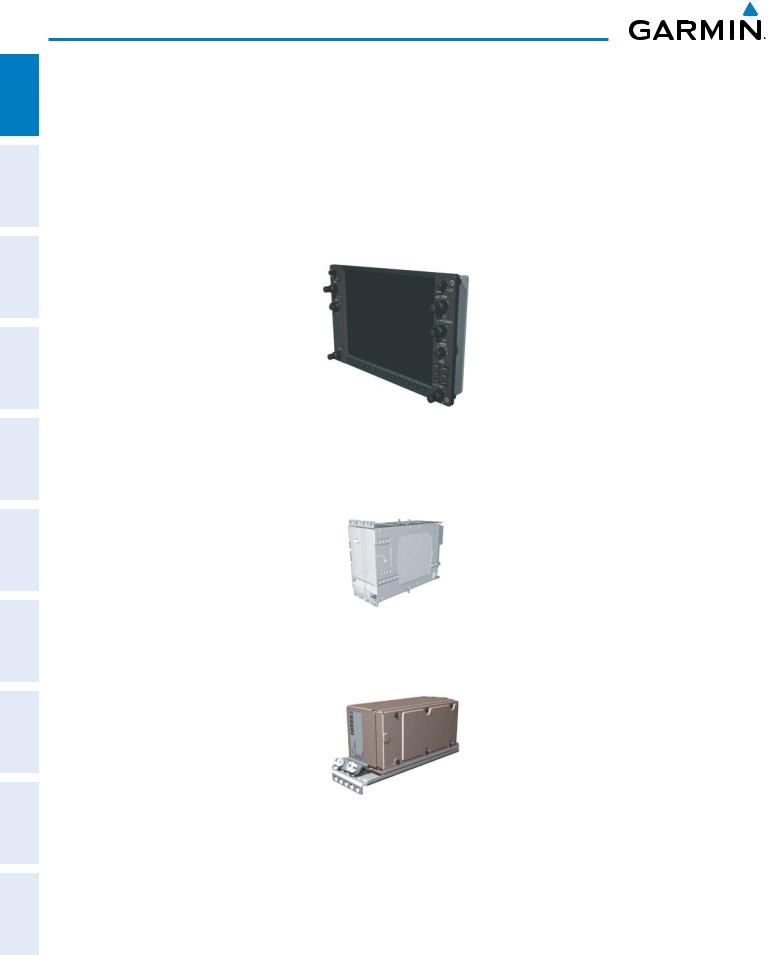
ADDITIONAL HAZARD FLIGHT AUDIO PANEL FLIGHT SYSTEM INDEX APPENDICES FEATURES AFCS AVOIDANCE MANAGEMENT & CNS EIS INSTRUMENTS OVERVIEW
SYSTEM OVERVIEW
1.2 LINE REPLACEABLE UNITS (LRU)
•GDU 1040/1044B – The GDU 1044B features a 10.4-inch LCD display with 1024 x 768 resolution. The left display is configured as a PFD and the right display is configured as an MFD. Both GDU 1044Bs link and display all functions of the G1000 system during flight. The displays communicate with each other through a High-Speed Data Bus (HSDB) Ethernet connection. Each display is also paired via an Ethernet connection with a GIA 63 or 63W Integrated Avionics Unit. Systems that do not use the GFC 700 Automatic Flight Control System use the GDU 1040, which employs the same features as the GDU 1044B without the controls for the Garmin GFC 700 Automatic Flight Control System (AFCS).
•GIA 63/63W (2) – Functions as the main communication hub, linking all LRUs with the PFD. Each GIA 63/63W contains a GPS receiver, VHF COM/NAV/GS receivers, a flight director (FD) and system integration microprocessors. The GIA 63W contains a GPS SBAS receiver. Each GIA is paired with a respective GDU 1040/1044B display through Ethernet. The GIAs are not paired together and do not communicate with each other directly.
•GDC 74A (1) – Processes data from the pitot/static system as well as the OAT probe. This unit provides pressure altitude, airspeed, vertical speed and OAT information to the G1000 system, and it communicates with the GIA 63/63W, GDU 1040/1044B, and GRS 77, using an ARINC 429 digital interface. The GDC 74A also interfaces directly with the GTP 59.
2 |
Garmin G1000 Pilot’s Guide for Cessna Nav III |
190-00498-07 Rev. A |

SYSTEM OVERVIEW
• GEA 71 (1) – Receives and processes signals from the engine and airframe sensors. This unit communicates |
SYSTEM OVERVIEW |
|
|
||
with both GIA 63/63Ws using an RS-485 digital interface. |
|
|
|
|
|
|
FLIGHT INSTRUMENTS |
|
• GRS 77 (1) – Provides aircraft attitude and heading information via ARINC 429 to both the GDU 1040/1044B |
|
|
and the GIA 63/63W. The GRS 77 contains advanced sensors (including accelerometers and rate sensors) and |
EIS |
|
interfaces with the on-side GMU 44 to obtain magnetic field information, with the GDC 74A to obtain air data, |
||
|
||
and with both GIAs to obtain GPS information. AHRS modes of operation are discussed later in this document. |
|
|
|
PANEL AUDIO CNS & |
|
• GMU 44 (1) – Measures local magnetic field. Data is sent to the GRS 77 for processing to determine aircraft |
FLIGHT MANAGEMENT |
|
|
||
magnetic heading. This unit receives power directly from the GRS 77 and communicates with the GRS 77 |
|
|
using an RS-485 digital interface. |
|
|
• GMA 1347 – The GMA 1347 Audio Panel integrates NAV/COM digital audio, intercom system and marker |
HAZARD AVOIDANCE |
|
beacon controls. The GMA 1347 also controls manual display reversionary mode (red DISPLAY BACKUP |
|
|
button) and is installed between the MFD and the PFD. The GMA 1347 communicates with both GIA 63/ |
|
|
63Ws using an RS-232 digital interface. |
AFCS |
|
|
||
|
ADDITIONAL FEATURES |
|
• GTX 33 (1) – The GTX 33 is a solid-state, Mode-S transponder that provides Modes A, C and S operation. The |
APPENDICES |
|
|
||
GTX 33 is controlled through the PFD and communicates with both GIA 63/63Ws through an RS-232 digital |
|
|
interface. |
|
|
|
INDEX |
190-00498-07 Rev. A |
Garmin G1000 Pilot’s Guide for Cessna Nav III |
3 |

SYSTEM OVERVIEW
ADDITIONAL HAZARD FLIGHT AUDIO PANEL FLIGHT SYSTEM INDEX APPENDICES FEATURES AFCS AVOIDANCE MANAGEMENT & CNS EIS INSTRUMENTS OVERVIEW
•GDL 69A (1) – A satellite radio receiver that provides real-time weather information to the G1000 MFD (and, indirectly, to the inset map of the PFD) as well as digital audio entertainment. The GDL 69A communicates with the MFD via HSDB connection. A subscription to the SiriusXM Satellite Radio service is required to enable the GDL 69A capability.
•GTS 800 – The GTS 800 Traffic Advisory System (TAS) uses active interrogations of Mode S and Mode C transponders to provide Traffic Advisories to the pilot independent of the air traffic control system.
•GDL 90 (1) – A digital data link transceiver designed to transmit, receive and decode ADS-B traffic information, as well as FIS-B weather information. It broadcasts aircraft position, velocity, projected track, altitude, and flight identification to other equipped aircraft in the vicinity, as well as to FAA ground stations. The GDL 90 receives FIS-B weather information which is displayed on the MFD as NEXRAD radar and METARs.
•GSA 81 (3), and GSM 85 (3) – The GSA 81 servos are used for the automatic control of roll, pitch, and pitch trim. These units interface with each GIA 63/63W.
The GSM 85 servo gearbox is responsible for transferring the output torque of the GSA 81 servo actuator to the mechanical flight-control surface linkage.
4 |
Garmin G1000 Pilot’s Guide for Cessna Nav III |
190-00498-07 Rev. A |
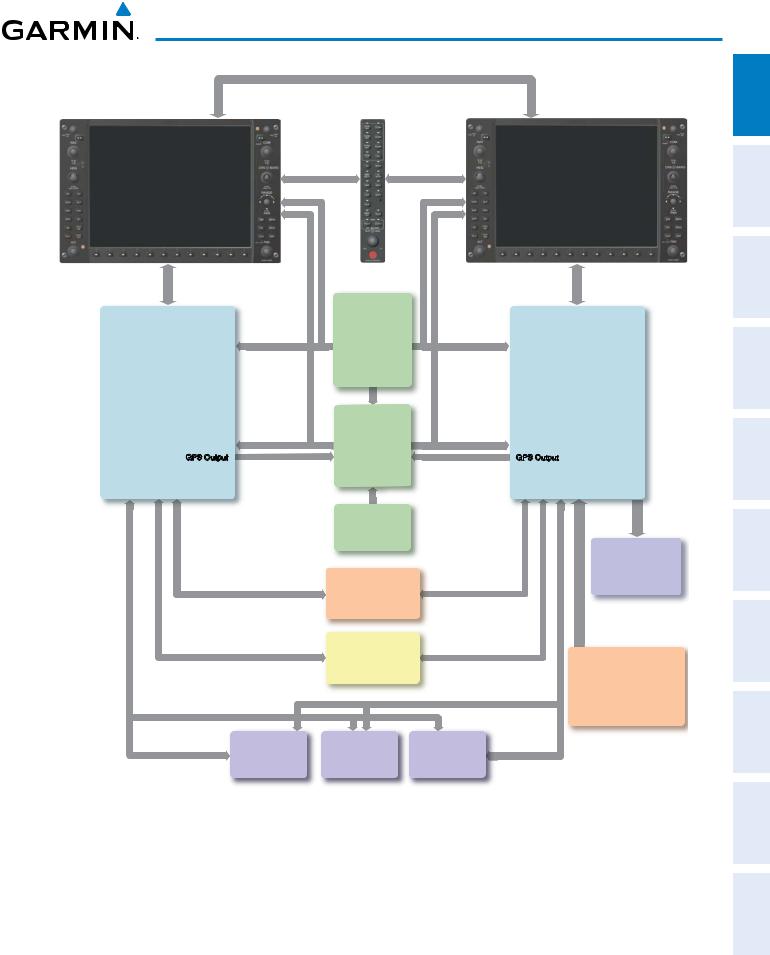
SYSTEM OVERVIEW
PFD |
|
|
MFD |
GDU 1040 or |
GMA 1347 |
GDU 1040 or |
|
GDU 1044B* |
Audio Panel |
GDU 1044B* |
|
|
Reversionary |
Reversionary |
|
|
Control |
|
Control |
GDC 74A
Air Data
Computer
No. 1 GIA 63/63W |
OAT |
No. 2 GIA 63/63W |
|
Integrated Avionics Unit |
Airspeed |
Integrated Avionics Unit |
|
Altitude |
|||
|
|
||
System Inegration Processors |
Vertical Speed |
System Integration Processors |
|
I/O Processors |
|
I/O Processors |
|
VHF COM |
|
VHF COM |
|
VHF NAV/LOC |
GRS 77 |
VHF NAV/LOC |
|
GPS/WAAS |
GPS/WAAS |
||
Glideslope |
AHRS |
Glideslope |
|
GFC 700 Flight Director |
|
||
|
|
||
(172S, 182, & 206) |
Attitude |
|
|
GPS Output |
GPS Output |
||
Rate of Turn |
|||
|
|
||
|
Slip/Skid |
|
GMU 44
Magnetometer
Heading
GTX 33
Transponder
GEA 71
 Engine/Airframe
Engine/Airframe 
Unit
GSA 81 |
GSA 81 |
GSA 81 |
Pitch Servo |
Pitch Trim |
Roll Servo |
Autopilot Calculations |
Autopilot Calculations |
Autopilot Calculations |
(172S/TD,182 & 206) |
(172S/TD,182 & 206) |
(172S/TD,182 & 206) |
Honeywell
KAP 140
Autopilot
GTS 800
TAS
or
GDL 90
Data Link
ADS-B Traffic Data
*The GDU 1040 is available in systems not using the GFC 700 Automatic Flight Control System.
The GDU 1044B is available in systems using the Garmin GFC 700 Automatic Flight Control System.
Figure 1-1 Basic G1000 System
INDEX APPENDICES ADDITIONALFEATURES AFCS AVOIDANCEHAZARD MANAGEMENTFLIGHT PANELCNSAUDIO& EIS INSTRUMENTSFLIGHT OVERVIEWSYSTEM
190-00498-07 Rev. A |
Garmin G1000 Pilot’s Guide for Cessna Nav III |
5 |
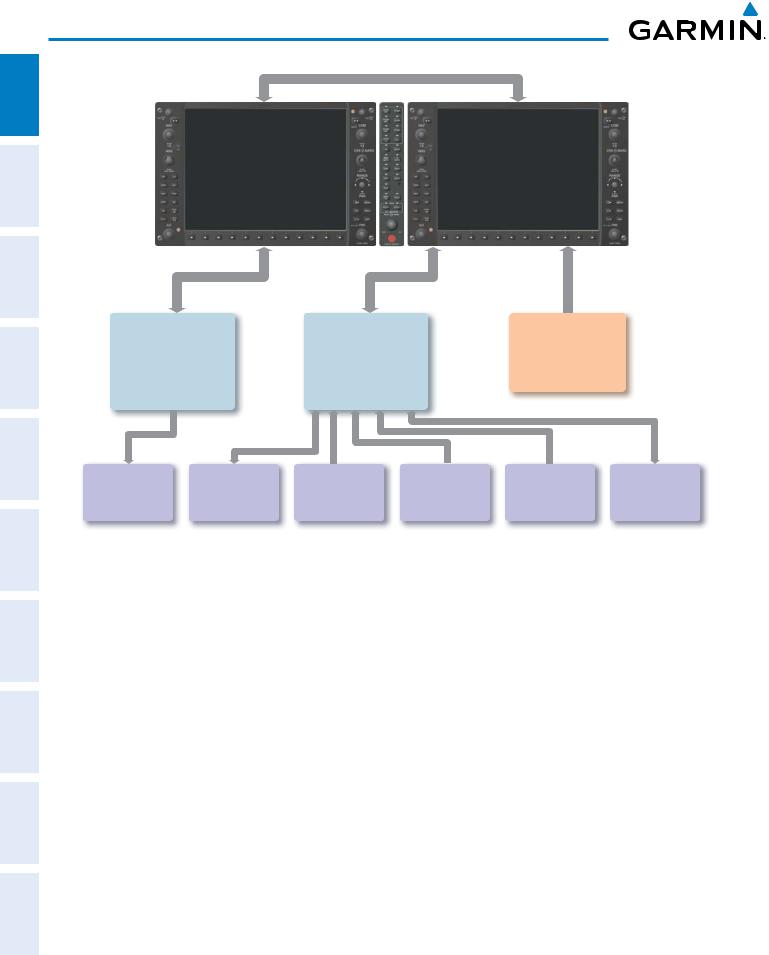
SYSTEM OVERVIEW
ADDITIONAL HAZARD FLIGHT AUDIO PANEL FLIGHT SYSTEM INDEX APPENDICES FEATURES AFCS AVOIDANCE MANAGEMENT & CNS EIS INSTRUMENTS OVERVIEW
No. 1 GIA 63/63W |
No. 2 GIA 63/63W |
|
|
Integrated Avionics Unit |
Integrated Avionics Unit |
GDL 69/69A |
|
System Integration Processors |
System Integration Processors |
Data Link |
|
I/O Processors |
I/O Processors |
||
Weather Data |
|||
VHF COM |
VHF COM |
||
Digital Audio Entertainment |
|||
VHF NAV/LOC |
VHF NAV/LOC |
||
|
|||
GPS |
GPS |
|
|
Glideslope |
Glideslope |
|
|
GFC 700 Flight Director |
|
|
ELT |
L3 |
Honeywell |
Honeywell |
CO Guardian |
Honeywell |
|
Stormscope |
||||||
Emergency Locator |
KR 87 |
KN 63 |
Carbon Monoxide |
KTA 870 |
||
Lightning Strike and |
Traffic Avoidance |
|||||
Transmitter |
ADF Receiver |
DME |
Detection |
|||
Thunderstorm Detection |
System |
|||||
|
|
|
|
Figure 1-2 Additional Equipment Options
6 |
Garmin G1000 Pilot’s Guide for Cessna Nav III |
190-00498-07 Rev. A |
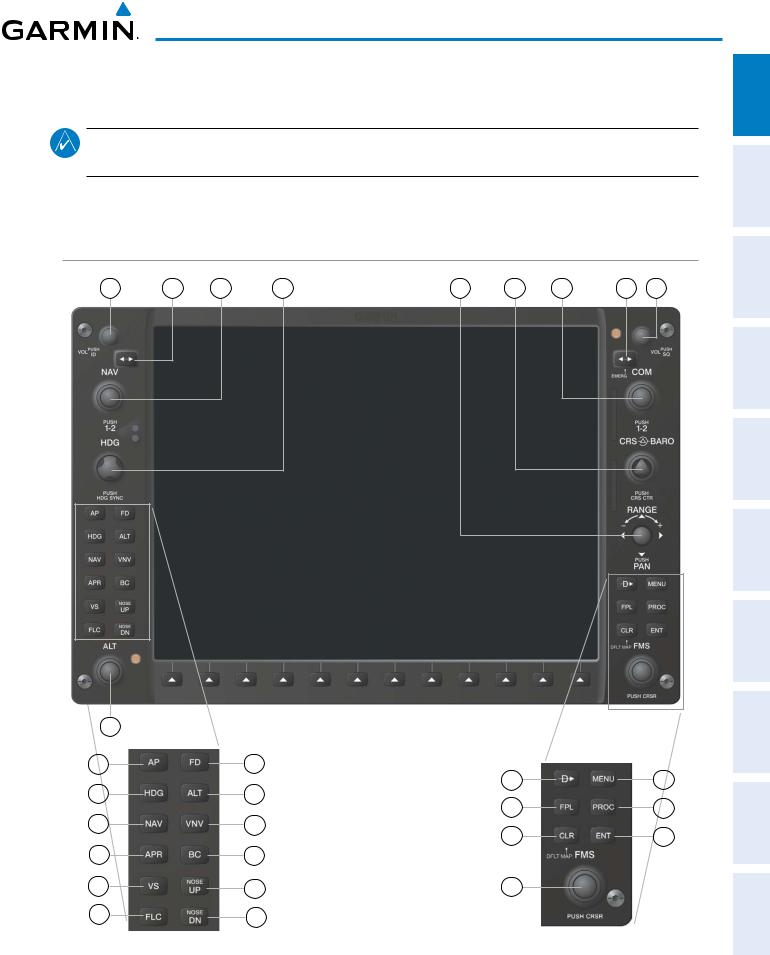
SYSTEM OVERVIEW
1.3 G1000 CONTROLS
NOTE: The Audio Panel (GMA 1347) and AFCS controls are described in the CNS & Audio Panel and AFCS sections respectively.
The G1000 system controls are located on the PFD and MFD bezels and audio panel. The controls for the PFD and MFD are discussed within the following pages of this section.
FLIGHT SYSTEM INSTRUMENTS OVERVIEW
PFD/MFD CONTROLS
1 |
2 |
3 |
4 |
5 |
6 |
7 |
8 |
9 |
17 |
|
|
|
|
18 |
24 |
|
14 |
|
19 |
25 |
10 |
||
11 |
15 |
|||
|
|
|||
20 |
26 |
12 |
16 |
|
|
|
|||
21 |
27 |
|
|
|
22 |
28 |
13 |
|
|
23 |
29 |
|
|
|
GFC 700 AFCS Only |
Figure 1-3 |
PFD/MFD Controls |
|
INDEX APPENDICES ADDITIONAL AFCS HAZARD FLIGHT PANEL AUDIO EIS FEATURES AVOIDANCE MANAGEMENT CNS &
190-00498-07 Rev. A |
Garmin G1000 Pilot’s Guide for Cessna Nav III |
7 |

SYSTEM OVERVIEW
ADDITIONAL HAZARD FLIGHT AUDIO PANEL FLIGHT SYSTEM INDEX APPENDICES FEATURES AFCS AVOIDANCE MANAGEMENT & CNS EIS INSTRUMENTS OVERVIEW
PFD and MFD control functions are the same.
1NAV VOL/ID Knob – Controls the NAV audio level. Press to toggle the Morse code identifier ON and OFF. Volume level is shown in the field as a percentage.
2NAV Frequency Transfer Key – Transfers the standby and active NAV frequencies.
3Dual NAV Knob – Tunes the MHz (large knob) and kHz (small knob) standby frequencies for the NAV receiver. Press to toggle the tuning cursor (light blue box) between the NAV1 and NAV2 fields.
4Heading Knob – Turn to manually select a heading on the HSI. When pressed, it synchronizes the heading bug with the compass lubber line. Selected Heading provides the heading reference to the Flight Director while operating in Heading Select mode.
5Joystick – Changes the map range (distance top to bottom of map display) when rotated. Activates the map pointer when pressed.
6CRS/BARO Knob – The large knob sets the altimeter barometric pressure and the small knob adjusts the course. The course is only adjustable when the HSI is in VOR1, VOR2, or OBS/SUSP mode. Pressing this knob centers the CDI on the currently selected VOR. Selected Course provides course reference to the Flight Director when operating in Navigation and Approach modes.
7Dual COM Knob – Tunes the MHz (large knob) and kHz (small knob) standby frequencies for the COM transceiver. Pressing this knob toggles the tuning cursor (light blue box) between the COM1 and COM2 fields.
8COM Frequency Transfer Key – Transfers the standby and active COM frequencies. Pressing and holding this key for two seconds automatically tunes the emergency frequency (121.5 MHz) in the active frequency field.
9COM VOL/SQ Knob – Controls COM audio level. Audio volume level is shown in the field as a percentage. Pressing this knob turns the COM automatic squelch ON and OFF.
10Direct-to Key – Allows the user to enter a destination waypoint and establish a direct course to the selected destination (specified by the identifier, chosen from the active route, or taken from the map pointer position).
11FPL Key – Displays the active Flight Plan Page for creating and editing the active flight plan, or for accessing stored flight plans.
12CLR Key (DFLT MAP) – Erases information, cancels an entry, or removes page menus. To display the Navigation Map Page immediately, press and hold CLR (MFD only).
13Dual FMS Knob – Press to turn the selection cursor ON/OFF.
Data Entry: With the cursor ON, turn to enter data in the highlighted field (large knob moves cursor location; small knob selects character for highlighted cursor location). When the cursor is turned ON while viewing the Active Flight Plan Page, the cursor is placed on the line below the Data Insertion Pointer see Figure 1-4. The pointer indicates data entered at the cursor will be inserted above the line selected.
Scrolling: When a list of information is too long for the window/box, a scroll bar appears, indicating more items to view. With cursor ON, turn large knob to scroll through the list.
Page Selection: Turn knob on MFD to select the page to view (large knob selects a page group; small knob selects a specific page from the group)
14MENU Key – Displays a context-sensitive list of options. This list allows the user to access additional features, or to make setting changes that relate to certain pages.
8 |
Garmin G1000 Pilot’s Guide for Cessna Nav III |
190-00498-07 Rev. A |
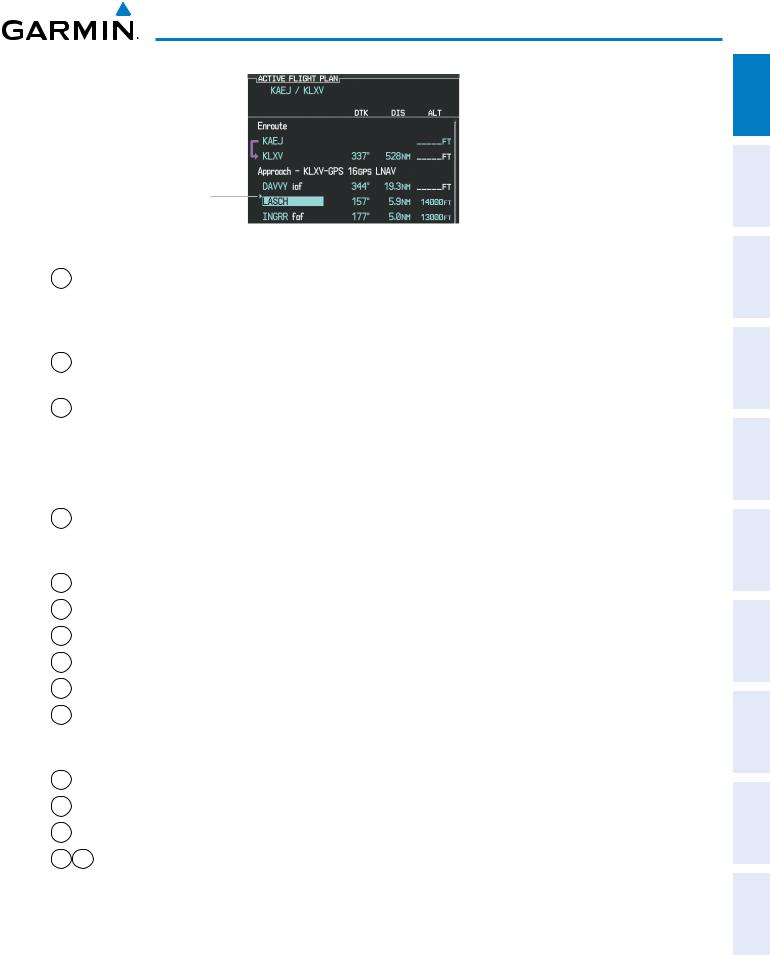
SYSTEM OVERVIEW
Data is Inserted Above the Cursor, Indicated by the Data Insertion Pointer
Figure 1-4 Data Insertion Pointer
15PROC Key – Selects approaches, departures and arrivals from the flight plan. If a flight plan is used, available procedures for the departure and/or arrival airport are automatically suggested. If a flight plan is not used, the desired airport and the desired procedure may be selected. This key selects IFR departure procedures (DPs), arrival procedures (STARs) and approaches (IAPs) from the database and loads them into the active flight plan.
16ENT Key – Accepts a menu selection or data entry. This key is used to approve an operation or complete data entry. It is also used to confirm selections and information entries.
17Dual ALT Knob – Sets the selected altitude in the box located above the Altimeter. The large knob selects the thousands (500m for metric), while the small knob selects the hundreds (50m for metric). Altitude Select is used by the Automatic Flight Control System in certain modes, in addition to the standard G1000 Altitude Alerter function.
The following are only available with the GFC 700 AFCS.
18AP Key – Engages/disengages the autopilot and flight director. Pressing the AP Key activates the flight director and engages the autopilot in the default pitch axis and roll axis modes. Pressing the AP Key again disengages the autopilot and deactivates the flight director.
19HDG Key – Selects/deselects Heading Select Mode.
20NAV Key – Selects/deselects Navigation Mode.
21APR Key – Selects/deselects Approach Mode.
22VS Key – Selects/deselects Vertical Speed Mode.
23 FLC Key – Selects/deselects Flight Level Change Mode.
24FD Key – Activates/deactivates the flight director only. Pressing the FD Key turns on the flight director in the default pitch axis and roll axis modes. Pressing the FD Key again deactivates the flight director and removes the command bars, unless the autopilot is engaged. If the autopilot is engaged, the FD Key is disabled.
25ALT Key – Selects/deselects Altitude Hold Mode.
26VNV Key – Selects/deselects Vertical Navigation Mode.
27BC Key – Selects/deselects Back Course Mode.
2829 NOSE UP/NOSE DN Keys – Controls the active pitch reference for the Pitch Hold, Vertical Speed, and Flight Level Change modes.
INDEX APPENDICES ADDITIONALFEATURES AFCS AVOIDANCEHAZARD MANAGEMENTFLIGHT PANELCNSAUDIO& EIS INSTRUMENTSFLIGHT OVERVIEWSYSTEM
190-00498-07 Rev. A |
Garmin G1000 Pilot’s Guide for Cessna Nav III |
9 |

ADDITIONAL HAZARD FLIGHT AUDIO PANEL FLIGHT SYSTEM INDEX APPENDICES FEATURES AFCS AVOIDANCE MANAGEMENT & CNS EIS INSTRUMENTS OVERVIEW
SYSTEM OVERVIEW
AUDIO PANEL CONTROLS
1 |
2 |
3 |
4 |
5 |
6 |
7 |
8 |
9 |
10 |
11 |
12 |
13 |
14 |
15 |
16 |
17 |
|
18 |
19 |
20 |
21 |
22 |
23 |
|
24 |
Figure 1-5 Audio Panel Controls (GMA 1347)
 NOTE: When a key is selected, a triangular annunciator above the key is illuminated.
NOTE: When a key is selected, a triangular annunciator above the key is illuminated.
1COM1 MIC – Selects the #1 transmitter for transmitting. COM1 receive is simultaneously selected when this key is pressed allowing received audio from the #1 COM receiver to be heard. COM2 receiver audio can be added by pressing the COM2 Key.
2COM1 – When selected, audio from the #1 COM receiver can be heard.
3COM2 MIC – Selects the #2 transmitter for transmitting. COM2 is simultaneously selected when this key is pressed allowing received audio from the #2 COM receiver to be heard. COM2 can be deselected by pressing the COM2 Key, or COM1 can be added by pressing the COM1 Key.
4COM2 – When selected, audio from the #2 COM receiver can be heard.
5COM3 MIC – Not used on Cessna Nav III aircraft.
10 |
Garmin G1000 Pilot’s Guide for Cessna Nav III |
190-00498-07 Rev. A |

SYSTEM OVERVIEW
6 |
COM3 – Not used on Cessna Nav III aircraft. |
SYSTEM OVERVIEW |
|
|
|||
7 |
COM 1/2 – Split COM is disabled on Cessna Nav III aircraft. |
|
|
8 |
TEL – Not used on Cessna Nav III aircraft. |
|
|
FLIGHT INSTRUMENTS |
|||
9 |
PA – Selects the Passenger Address system. The selected COM transmitter is deselected when the PA Key |
||
|
is pressed. The Passenger Address system is disabled on the Cessna 172R/S.
10SPKR – Selects and deselects the cabin speaker. COM and NAV receiver audio can be heard on the speaker.
11MKR/MUTE – Mutes the currently received marker beacon receiver audio. Unmutes when new marker beacon audio is received. Also, stops play of the clearance recorder.
12HI SENS – Press to increase marker beacon receiver sensitivity. Press again to return to normal.
13DME – Pressing turns DME audio on or off.
14NAV1 – When selected, audio from the #1 NAV receiver can be heard.
15ADF – Pressing turns on or off the audio from the ADF receiver.
16NAV2 – When selected, audio from the #2 NAV receiver can be heard.
17AUX – Not used on Cessna Nav III aircraft.
18MAN SQ – Press to enable manual squelch for the intercom. When active, press the PILOT Knob to illuminate ‘SQ’. Turn the PILOT/PASS Knobs to adjust squelch.
19PLAY – Press once to play the last recorded audio. Pressing the PLAY Key during play begins playing the previously recorded memory block. Each subsequent press of the PLAY Key begins playing the next previously recorded block. Press the MKR/MUTE Key to stop play.
20PILOT – Pressing selects the pilot intercom isolation. Press again to deselect pilot isolation.
21COPLT – Pressing selects the copilot intercom isolation. Press again to deselect copilot isolation.
22PILOT Knob – Press to switch between volume and squelch control as indicated by the ‘VOL’ or ‘SQ’ being illuminated. Turn to adjust intercom volume or squelch. The MAN SQ Key must be selected to allow squelch adjustment.
23PASS Knob – Turn to adjust Copilot/Passenger intercom volume or squelch. The MAN SQ Key must be selected to allow squelch adjustment.
24Reversionary Mode Button – Pressing manually selects Reversionary Mode.
INDEX APPENDICES ADDITIONAL AFCS HAZARD FLIGHT PANEL AUDIO EIS FEATURES AVOIDANCE MANAGEMENT CNS &
190-00498-07 Rev. A |
Garmin G1000 Pilot’s Guide for Cessna Nav III |
11 |
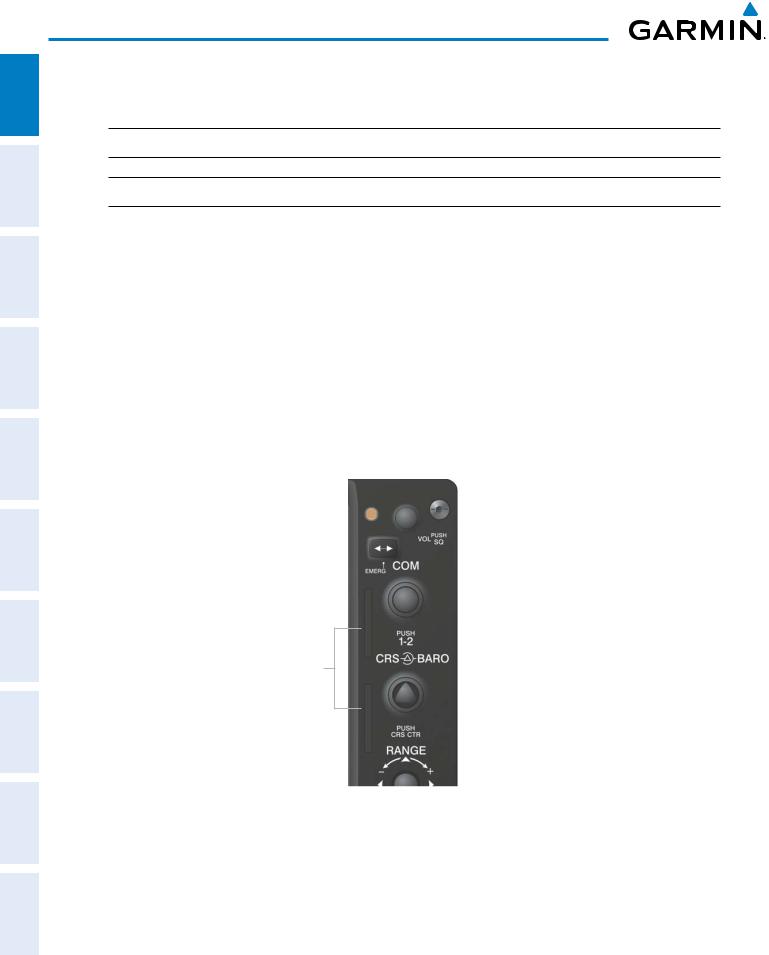
ADDITIONAL HAZARD FLIGHT AUDIO PANEL FLIGHT SYSTEM FEATURES AFCS AVOIDANCE MANAGEMENT & CNS EIS INSTRUMENTS OVERVIEW
SYSTEM OVERVIEW
1.4 SECURE DIGITAL (SD) CARDS
 NOTE: Ensure the G1000 System is powered off before inserting an SD card.
NOTE: Ensure the G1000 System is powered off before inserting an SD card.
 NOTE: Refer to Appendix B for instructions on loading database updates.
NOTE: Refer to Appendix B for instructions on loading database updates.
The PFD and MFD data card slots use Secure Digital (SD) cards and are located on the upper right side of the display bezels. SD cards are used for storing the various databases and system software updates. Each display bezel is equipped with two SD card slots. The top slot is used for importing and exporting flight plans, Flight Data Logging, and loading navigation database updates. The bottom slot of each display contains a Garmin Supplemental Data Card which is used for storing the various databases.
Not all SD cards are compatible with the G1000. Use only SD cards supplied by Garmin or the aircraft manufacturer.
Installing an SD card:
1)Insert the SD card in the SD card slot, pushing the card in until the spring latch engages. The front of the card should remain flush with the face of the display bezel.
2)To eject the card, gently press on the SD card to release the spring latch.
SD Card Slots
INDEX APPENDICES
Figure 1-6 Display Bezel SD Card Slots
12 |
Garmin G1000 Pilot’s Guide for Cessna Nav III |
190-00498-07 Rev. A |

SYSTEM OVERVIEW
1.5 SYSTEM POWER-UP
NOTE: See the Aircraft Flight Manual (AFM) for specific procedures concerning avionics power application and emergency power supply operation.
 NOTE: Refer to Appendix A for system-specific annunciations and alerts.
NOTE: Refer to Appendix A for system-specific annunciations and alerts.
The G1000 System is integrated with the aircraft electrical system and receives power directly from electrical busses. The G1000 PFD, MFD, and supporting sub-systems include both power-on and continuous built-in test features that exercise the processor, RAM, ROM, external inputs, and outputs to provide safe operation.
During system initialization, test annunciations are displayed, as shown in Figure 1-7. All system annunciations should disappear typically within the first minute of power-up. Upon power-up, key annunciator lights also become momentarily illuminated on the Audio Panel.
On the PFD, the AHRS begins to initialize and displays “AHRS ALIGN: Keep Wings Level”. The AHRS should display valid attitude and heading fields typically within the first minute of power-up. The AHRS can align itself both while taxiing and during level flight.
When the MFD powers up, the power-up screen (Figure 1-8) displays the following information:
• System version |
• Obstacle database name and version |
• Copyright |
• Navigation database name, version, and effective dates |
• Land database name and version |
• Airport Directory name, version and effective dates |
• Safe Taxi database information |
• FliteCharts/ChartView database information |
• Terrain database name and version |
|
Current database information includes database type, cycle number, or valid operating dates. Review the listed information for currency (to ensure that no databases have expired).
Pressing the ENT Key (or right-most softkey) acknowledges this information, and the Navigation Map Page is displayed upon pressing the key a second time. When the system has acquired a sufficient number of satellites to determine a position, the aircraft’s current position is shown on the Navigation Map Page.
APPENDICES ADDITIONALFEATURES AFCS AVOIDANCEHAZARD MANAGEMENTFLIGHT PANELCNSAUDIO& EIS INSTRUMENTSFLIGHT OVERVIEWSYSTEM
Figure 1-7 PFD Initialization |
Figure 1-8 MFD Power-Up Screen (172R shown) |
INDEX
190-00498-07 Rev. A |
Garmin G1000 Pilot’s Guide for Cessna Nav III |
13 |
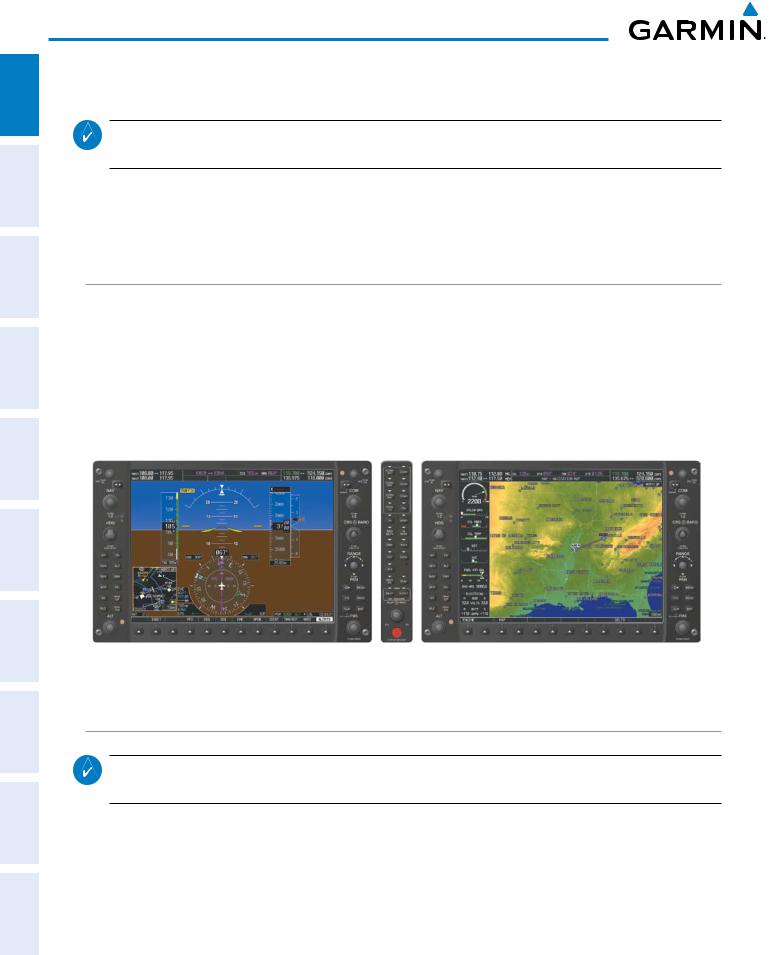
ADDITIONAL HAZARD FLIGHT AUDIO PANEL FLIGHT SYSTEM INDEX APPENDICES FEATURES AFCS AVOIDANCE MANAGEMENT & CNS EIS INSTRUMENTS OVERVIEW
SYSTEM OVERVIEW
1.6 SYSTEM OPERATION
NOTE: In normal operating mode, backlighting can only be adjusted from the PFD. In reversionary mode, it can be adjusted from the remaining display.
The displays are connected together via a single Ethernet bus for high-speed communication. Each IAU is connected to a single display, as shown in Figure 1-1. This allows the units to share information, enabling true system integration.. This section discusses normal and reversionary G1000 display operation, as well as the various AHRS modes and G1000 System Annunciations.
NORMAL DISPLAY OPERATION
In normal operating mode, the PFD presents graphical flight instrumentation (attitude, heading, airspeed, altitude, vertical speed), replacing the traditional flight instrument cluster (see the Flight Instruments Section for more information).
The MFD normally displays a full-color moving map with navigation information (see the Flight Management Section), while the left portion of the MFD is dedicated to the Engine Indication System (EIS; see the EIS Section).
Both displays offer control for COM and NAV frequency selection.
Figure 1-9 Normal Mode
REVERSIONARY DISPLAY OPERATION
NOTE: The G1000 System alerts the pilot when backup paths are utilized by the LRUs. Refer to Appendix A for further information regarding system-specific alerts.
In the event of a display failure, the G1000 System automatically switches to reversionary (backup) mode. In reversionary mode, all important flight information is presented on the remaining display in the same format as in normal operating mode.
14 |
Garmin G1000 Pilot’s Guide for Cessna Nav III |
190-00498-07 Rev. A |
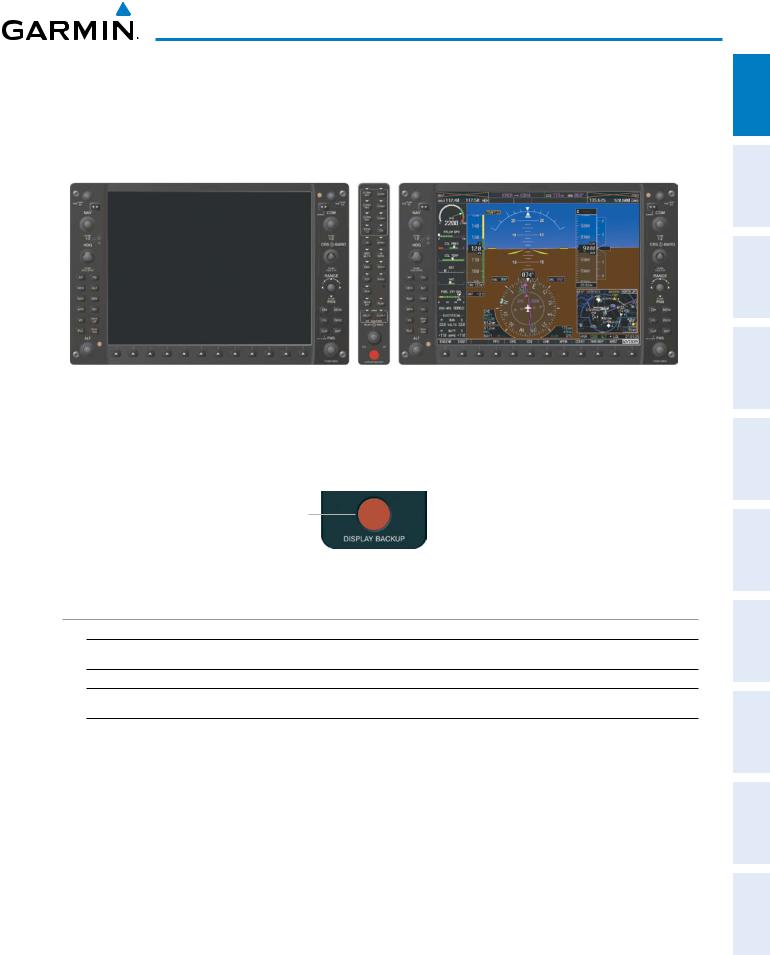
SYSTEM OVERVIEW
If a display fails, the appropriate IAU Ethernet interface to the display is cut off. Thus, the IAU can no longer communicate with the remaining display (refer to Figure 1-1), and the NAV and COM functions provided to the failed display by the IAU are flagged as invalid on the remaining display. The system reverts to backup paths for the AHRS, ADC, Engine/Airframe Unit, and Transponder, as required. The change to backup paths is completely automated for all LRUs and no pilot action is required.
Figure 1-10 Reversionary Mode (Failed PFD)
If the system fails to detect a display problem, reversionary mode may be manually activated by pressing the Audio Panel’s red DISPLAY BACKUP button (refer to the Audio Panel and CNS Section for further details). Pressing this button again deactivates reversionary mode.
Pressing the DISPLAY BACKUP button activates/deactivates reversionary mode
Figure 1-11 DISPLAY BACKUP Button
AHRS OPERATION
 NOTE: Refer to Appendix A for specific AHRS alert information.
NOTE: Refer to Appendix A for specific AHRS alert information.
 NOTE: Aggressive maneuvering while AHRS is not operating normally may degrade AHRS accuracy.
NOTE: Aggressive maneuvering while AHRS is not operating normally may degrade AHRS accuracy.
The Attitude and Heading Reference System (AHRS) performs attitude, heading, and vertical acceleration calculations for the G1000 System, utilizing GPS, magnetometer, and air data in addition to information from its internal sensors. Attitude and heading information are updated on the PFD while the AHRS receives appropriate combinations of information from the external sensor inputs.
Loss of GPS, magnetometer, or air data inputs is communicated to the pilot by message advisory alerts. Any failure of the internal AHRS inertial sensors results in loss of attitude and heading information (indicated by red ‘X’ flags over the corresponding flight instruments).
INDEX APPENDICES ADDITIONALFEATURES AFCS AVOIDANCEHAZARD MANAGEMENTFLIGHT PANELCNSAUDIO& EIS INSTRUMENTSFLIGHT OVERVIEWSYSTEM
190-00498-07 Rev. A |
Garmin G1000 Pilot’s Guide for Cessna Nav III |
15 |
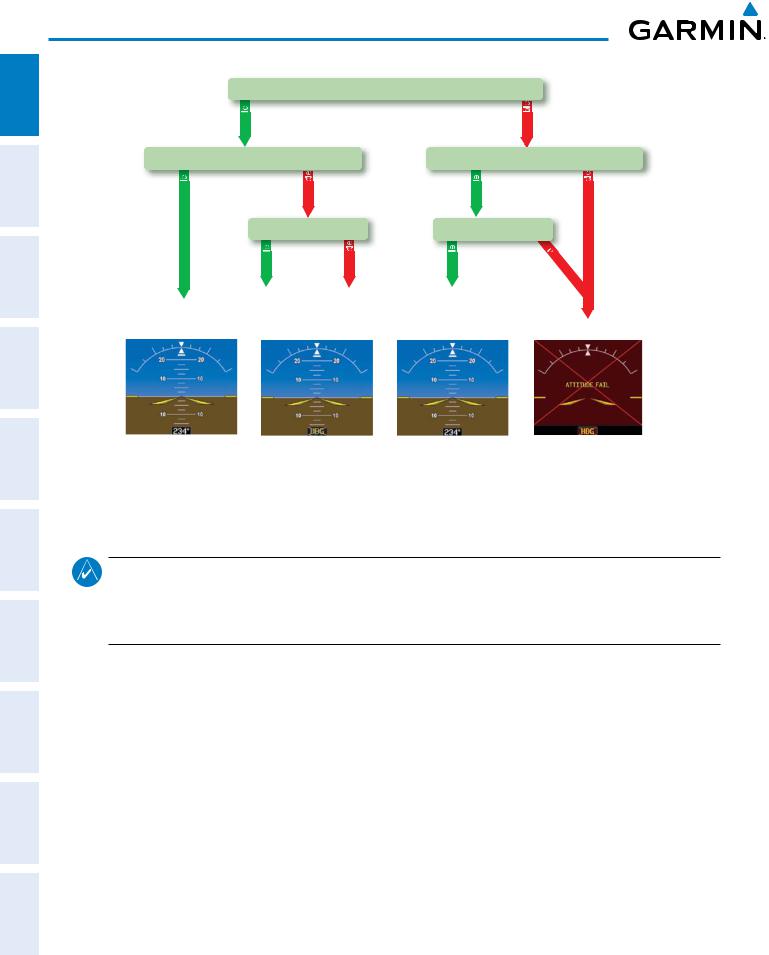
SYSTEM OVERVIEW
ADDITIONAL HAZARD FLIGHT AUDIO PANEL FLIGHT SYSTEM INDEX APPENDICES FEATURES AFCS AVOIDANCE MANAGEMENT & CNS EIS INSTRUMENTS OVERVIEW
GPS Data
|
availab |
|
|
unavailab |
|
Magnetometer Data |
Magnetometer Data |
||||
availab |
|
unavailab |
availab |
unavailab |
|
|
Air Data |
Air Data |
|||
|
availab |
unavailab |
availab |
una |
|
|
v |
||||
|
ailab |
||||
|
le |
||||
AHRS Normal |
AHRS no- |
AHRS no-Mag/ |
AHRS |
|
|
Mag Mode |
no-Air Mode |
no-GPS |
|
||
Operation |
Attitude/Heading Invalid |
||||
Heading Invalid |
Mode |
||||
|
|||||
Figure 1-12 AHRS Operation
GPS INPUT FAILURE
NOTE: In-flight initialization of AHRS, when operating without any valid source of GPS data and at true air speed values greater than approximately 200 knots, is not guaranteed. Under these rare conditions, it is possible for in-flight AHRS initialization to take an indefinite amount of time which would result in an extended period of time where valid AHRS outputs are unavailable.
Two GPS inputs are provided to the AHRS. If GPS information from one of the inputs fails, the AHRS uses the remaining GPS input and an alert message is issued to inform the pilot. If both GPS inputs fail, the AHRS can continue to provide attitude and heading information to the PFD as long as magnetometer and airspeed data are available and valid.
MAGNETOMETER FAILURE
If the magnetometer input fails, the AHRS continues to output valid attitude information; however, the heading output on the PFD is flagged as invalid with a red ‘X’.
AIR DATA INPUT FAILURE
Failure of the air data input has no affect on the AHRS output while AHRS is receiving valid GPS information. Invalid/unavailable airspeed data in addition to GPS failure results in loss of all attitude and heading information.
16 |
Garmin G1000 Pilot’s Guide for Cessna Nav III |
190-00498-07 Rev. A |
